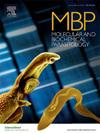Metronidazole induces prostaglandin E2 formation via arachidonic acid production in protozoan parasite Giardia lamblia
IF 1.4
4区 医学
Q4 BIOCHEMISTRY & MOLECULAR BIOLOGY
引用次数: 0
Abstract
The causative agent of giardiasis in human and animals is the amitochondriate Giardia lamblia. We observed that exposing Giardia trophozoites to MTZ led to an increase in lipid peroxidation compared to the control group, which was expressed in terms of menadione production as it is the marker for lipo-peroxidation. Oxidative stress generated by reactive nitrogen species and peroxidation of membrane phospholipids are positively correlated with the enhanced PLA2 activity in several organisms to produce arachidonic acid (AA). Our data suggested Giardia produces a unique 56 kDa dimeric enzyme called Phospholipase B (gPLB) in contrast to higher eukaryotes which was responsible for the production of intracellular free AA. This free AA either reacylates to the cell membrane or deacylates to further produce prostaglandins. In normal un-induced controlled trophozoites the membrane reacylation process was dominant due the higher level of acyle CoA synthase (ACS) expression over the time. However, under the oxidative stressed condition the intracellular ACS expression was down regulated. This led to the increase in deacylation process. When AA deacylation becomes dominant over AA reacylation in cells, the free AA accumulates intracellularly. One of the lipid autacoids, derived from AA is prostaglandin2 (PGE2). Oxidative stress generated by reactive nitrogen species in trophozoites increased the PGE2 production via prostaglandin synthase over the time with respect to the controlled one.
甲硝唑诱导原生动物贾第鞭毛虫产生花生四烯酸形成前列腺素E2。
人类和动物贾第虫病的病原体是带线粒体的贾第虫。我们观察到,与对照组相比,将贾第鞭毛虫滋养体暴露于MTZ导致脂质过氧化增加,这表现为甲萘醌的产生,因为它是脂质过氧化的标志。活性氮产生的氧化应激和膜磷脂的过氧化与几种生物产生花生四烯酸(AA)的PLA2活性增强呈正相关。我们的数据表明贾第鞭毛虫产生一种独特的56kDa二聚体酶,称为磷脂酶B (gPLB),与高级真核生物相比,它负责产生细胞内游离AA。这种游离的AA要么再乙酰化到细胞膜上,要么去乙酰化进一步产生前列腺素。在正常的未诱导的控制滋养体中,由于随着时间的推移,环辅酶a合成酶(ACS)的表达水平较高,膜再酰基化过程占主导地位。而在氧化应激条件下,细胞内ACS表达下调。这导致了去酰化过程的增加。当细胞内AA去酰化作用大于AA再酰化作用时,游离AA在细胞内积累。其中一种脂质类自身素,来源于AA是前列腺素2 (PGE2)。活性氮在滋养体中产生的氧化应激随着时间的推移增加了前列腺素合成酶产生的PGE2。
本文章由计算机程序翻译,如有差异,请以英文原文为准。
求助全文
约1分钟内获得全文
求助全文
来源期刊
CiteScore
2.90
自引率
0.00%
发文量
51
审稿时长
63 days
期刊介绍:
The journal provides a medium for rapid publication of investigations of the molecular biology and biochemistry of parasitic protozoa and helminths and their interactions with both the definitive and intermediate host. The main subject areas covered are:
• the structure, biosynthesis, degradation, properties and function of DNA, RNA, proteins, lipids, carbohydrates and small molecular-weight substances
• intermediary metabolism and bioenergetics
• drug target characterization and the mode of action of antiparasitic drugs
• molecular and biochemical aspects of membrane structure and function
• host-parasite relationships that focus on the parasite, particularly as related to specific parasite molecules.
• analysis of genes and genome structure, function and expression
• analysis of variation in parasite populations relevant to genetic exchange, pathogenesis, drug and vaccine target characterization, and drug resistance.
• parasite protein trafficking, organelle biogenesis, and cellular structure especially with reference to the roles of specific molecules
• parasite programmed cell death, development, and cell division at the molecular level.

 求助内容:
求助内容: 应助结果提醒方式:
应助结果提醒方式:


